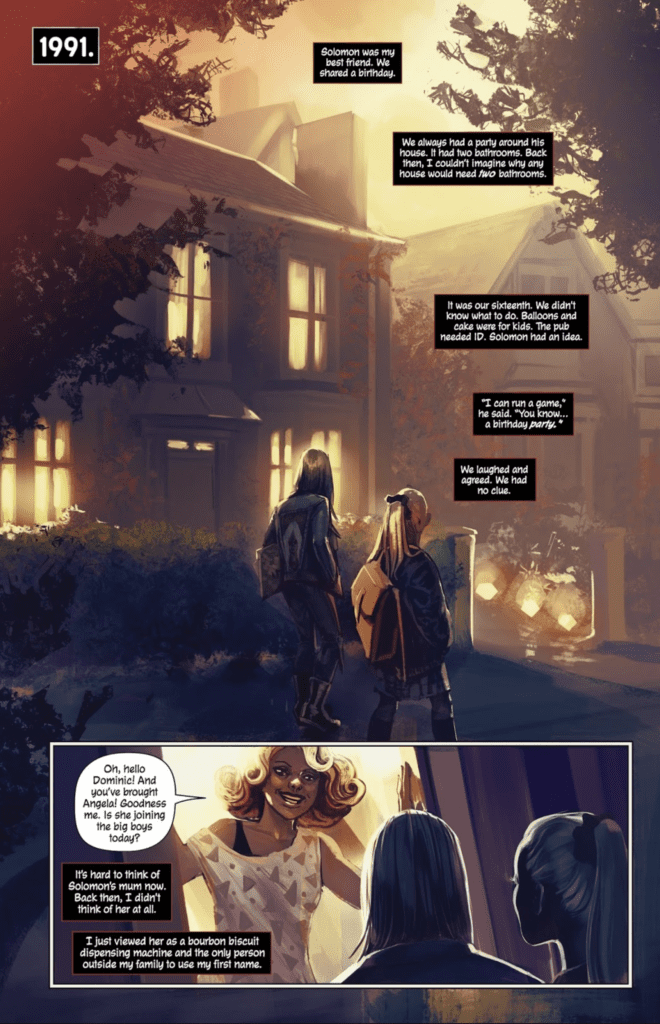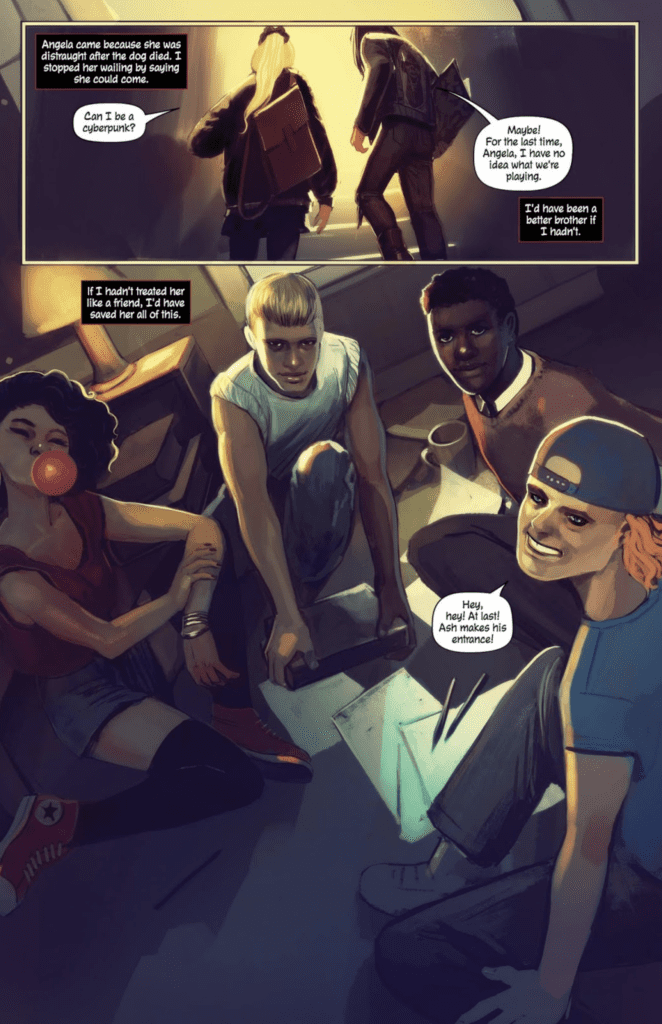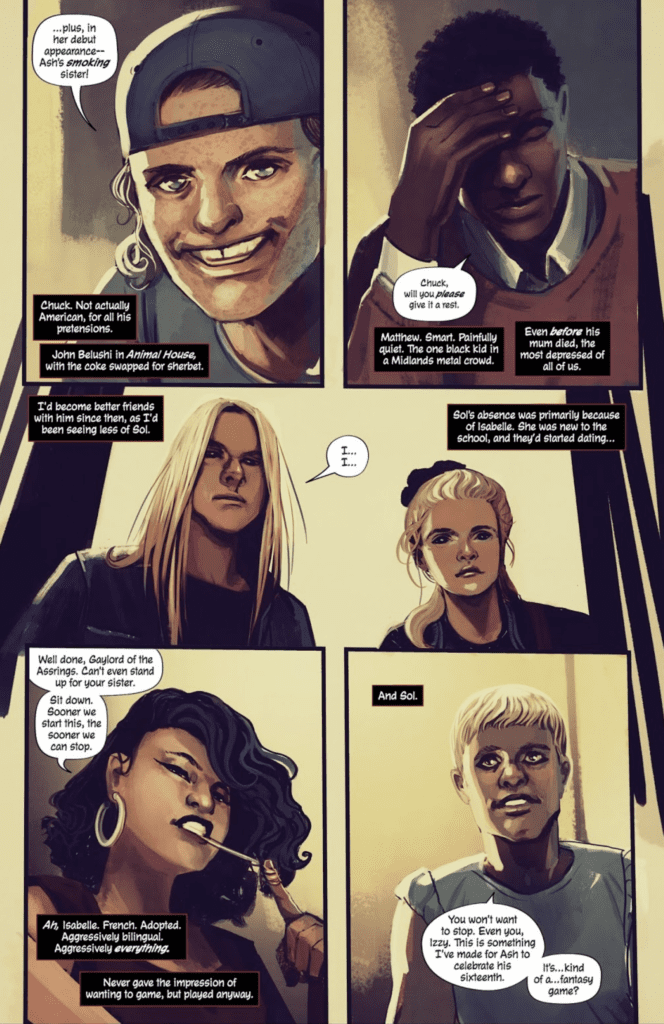Writer Kieron Gillen and artist Stephanie Hans are pushing the envelope with their insane new series DIE, published by Image Comics.
About the series – DIE is a pitch-black fantasy where a group of forty-something adults have to deal with the returning unearthly horror they barely survived as teenage role-players. If Kieron’s in a rush, he describes it as “Goth Jumanji.” That only captures a sliver of what you’ll find in oversized debut issue—where fantasy gets all too real.
DIE #1 hits your local comic book store on December 5. Gillen and Hans spoke with Monkeys Fighting Robots for a behind-the-scenes look at the new ongoing series. Don’t miss the BONUS MATERIAL after the interview: three unlettered pages from the first issue to really appreciate Hans’ art style, and boy does the color pop.
Monkeys Fighting Robots: Kieron, a 2009 survey found that the Bourbon biscuit was the fifth most popular biscuit in the UK to dunk into tea. Where does it rank on your list?
KIERON GILLEN: Relatively low for me, actually. As a child, a custard cream tops it, and a Jammie Dodger reigns supreme over them all. As an adult, the humble Digestive is a beast, and an easy way to see how flush I am feeling is whether I buy a Chocolate HobNobs or plain hobnobs.
Clearly, Dominic feels differently, which was a huge stretch for me as a writer, but I made these sacrifices for fictions.
MFR: I have this theory that the current generation in his or her 40s was not prepared for the 40s. We’re having kids later, so we don’t have time for a mid-life crisis. Now, if you put 20 years in at a corporate job you’re probably going to get fired and replaced with someone younger and cheaper. The roadmap has changed significantly compared to previous generations.
KIERON: I think you capture a bunch of stuff here. I mean, this is one of my things – I’m interested how we can see cycles of life repeating time and time over (hence, some people say “nothing changes”) while the specifics change almost entirely (hence, some people say “everything changes”). Neither is true, and both are true, being the point. In this case, I have been fascinating watching creators of the generation just before me doing their own take on what it’s like to pass through this stage in life – watching Trainspotting 2 and The World’s End was fascinating for me.
So, yes, I think it’s a book which is about all those trends – the difficulty of jobs, the impermanence, the extension of adolescence and youth culture and all that. I mean, in terms of Mid-life crisis stuff, I suspect it’s less that it doesn’t happen and more the emotions which provoked that behavior come out in other ways.
But, as you say – how many people do you know who have worked in the same place for 20 years now?
MFR: The characters in DIE are in his or her 40s. What are your feelings on being in your 40s, and how does it influence your writing?
STEPHANIE HANS: If I may, you better make time for your mid-life crisis, because ready or not, it will come. But It can also bring a lot of happiness if you listen to yourself. Sometimes you need a change of paradigm.
KIERON: One thing I knew about whatever I did after WicDiv – I didn’t want it to star young people. I wanted to write about people at least as old as I am. That I somehow wandered into being known as someone who writes young people is this really odd quirk of my career – Journey into Mystery (where I inherited Loki as a kid – my original plan was an Elric-styled Loki), Young Avengers (which was a book I had to literally be talked into doing) and WicDiv (which had various reasons, but primarily realpolitik after YA’s success.) It’s a quirk, but also one which I knew I had little interest in doing again, at least in the same way. I’ve spent my time in the last few years turning down anyone who offered me a teen character.
How do I feel about being in my 40s? Still working it out, really. DIE is certainly part of that. WicDiv was really my midlife crisis book. DIE is a book about living with it, in some way.

MFR: Stephanie, DIE #1 is tense, how do convey this with your art? Do you use different visual angles?
STEPHANIE: It’s simple sequential art. You use angles to imply doom, action, silence, tension. And in my case, I also use light and shadows a lot.
MFR: How do you approach panel design for a book like DIE? The overlapping panel design on a page for me gives the book a more movement.
STEPHANIE: I tend to have a very strict sequencing. I don’t really like when things get out of panels if I do it, it needs to have some sense. The only fancy thing I allow myself is the tilting of panels for dynamism in action scenes. Chaotic action gives chaotic panels.
I see the panels a lot like notes of music, so they follow the rhythm of the story. Quick sequence: short panels
MFR: Kieron, did you need to write this book or did you want to write this book?
KIERON: Are you angling for me to quote the Watchmen Rorschach bit? “We do not do this thing because it is permitted. We do it because we have to. We do it because we are compelled.”
I used to think like that, and that it’s what Rorschach says should have been the tell that something is off. When I had the idea of DIE, it jumped to the top of my to-do list. It so clearly something that spoke to me deeply and created a painful emotional response. That may imply a need over a want. There was no other choice…
However, now I’m asked as cleanly as you have, it makes me sit back and re-examine it. I lean existentialist. Just because the desire and the compulsion are there, saying you “needed” to do it is letting yourself off the hook. Of course, it was a choice. I needed to do this, I wanted to do this and I chose to follow those impulses. And that’s appropriate, innit? To paraphrase Sid Meier, games are a series of interesting choices.
MFR: Stephanie, how did you decide your color palette for the DIE world?
STEPHANIE: I always try to use simple color palettes in my work. I like to assign a general mood /color to a scene and stick to it. If there is some action implied, the color palette becomes more radical, with less nuances. Because when there is an action, you get focused and the background and everything that is not important becomes vague, as in real life.
I use the gradient map tool on photoshop to build a base for each sequence and then work more steadily on details.
I also apply some simple reasoning to the construction of the colors. Some kind of passed instagrammy colors for the past, with brownish undertones, shaper but bleak colors for real life, vivid colors for the other world. Then there are also flashbacks, which are a bit different too.
MFR: Kieron, the first issue is very depressing; do we get to a heroic point in the series? (Does Dominic ever get a haircut?)
KIERON: Oh, rest assured, the equivalent of orcs getting stabbed. And then we unpack the concept of orcs, as we just can’t help ourselves.
It’s a bleakly heroic kind of book. We’re all about stabbing and emotions.
Dominic’s future haircut is clearly the most spoilerific of all spoilers.
MFR: DIE is an ongoing series, how far out do you have the outline?
KIERON: I’m a systemic writer. I write towards conclusions. As in, I know where we end up, and the dramatic poles that all the arcs follow. However, like WicDiv, there’s lots of space in terms of execution. It’s a big world, in every way, and I want space to dig into things my research turns up. I mean, I’ve finally worked out the perfect place to get Lovecraft in, and it’s the fourth arc.
MFR: Independent comics is a tough business, how do you both define success?
STEPHANIE: It is my first creator-owned and my first ongoing. I have nothing to lose. I work with a team that I trust and chose, and the story we are working on is truly a work of love. Neither of us need to work on this book for other reasons than because we really want to. Seeing it published, seeing people loving it, it is already a huge thing for me.
We talked about mid-life crisis earlier. Mine taught me to enjoy the ride.
KIERON: There are two sides of it. Success is actually reaching the people a story is meant to reach and move. I’ve been enormously lucky with my books. I’m someone whose life was changed by art. I wanted to do the same for other people. That I have is absolutely the impossible success.
The other side of it is purely practical – success is getting to do this. I just realized I’ve crossed my twentieth year of being a full-time writer, in various media and mode. I worked building sites when I was a teen. That was hard work. Me not having to do that is completely all the success I need. I’m very lazy.
MFR: How long would each of you last in the DIE world?
STEPHANIE: I am pretty sure I would do great there. Certainly wouldn’t want to leave. Honestly, if we find a way to bring WIFI, I’ll be good.
Also, most of the characters I ever played were chaotic neutral and I always thought that those were the most adapted to survival.
KIERON: Conversely, one of the Fallen will have ripped me apart in about five minutes.
MFR: In the first issue, the reader only sees a glimpse of the DIE world. What type of monsters can we expect?
KIERON: The monsters always speak to the world and the players. The monsters are really about a chance for the characters to be monsters in DIE.
Stepping aside from the metaphysical handwaving, I promised Stephanie a dragon by issue 3, and she totally gets her dragon, and it’s just a wonder.
What did you think of the interview? Are you going to add DIE to your pull list? Comment below, and thank you for reading.




